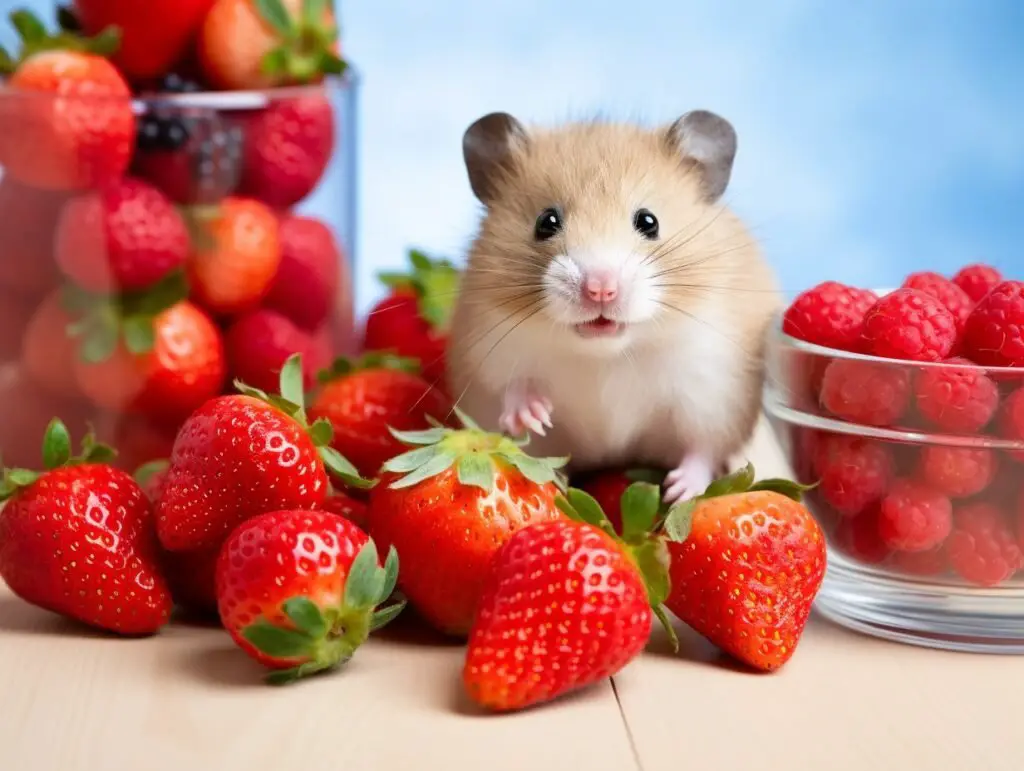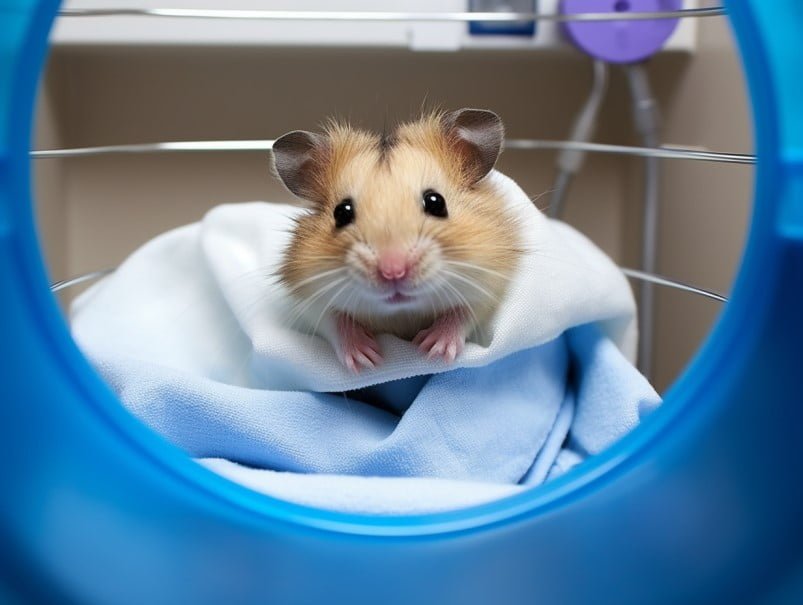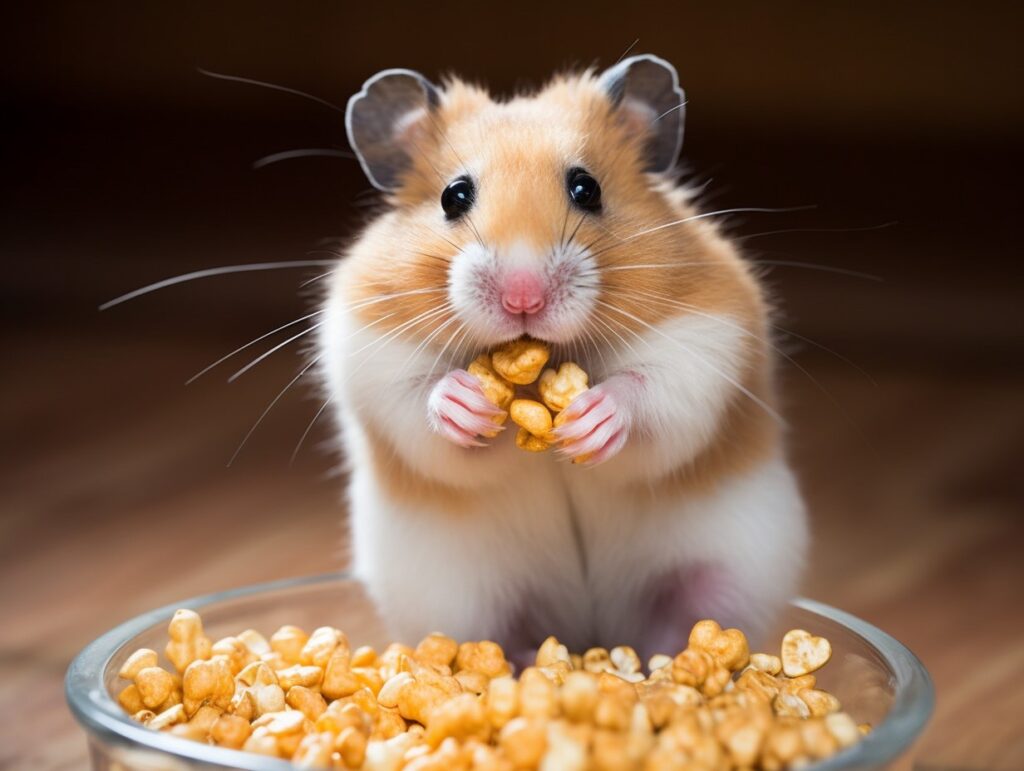Curious if hamsters can eat strawberries?
If you’re a hamster owner, you’ve probably found yourself wondering about the different types of food your pet can eat. And, if you’re a fan of fresh fruits, you may have asked the question: Can hamsters eat strawberries?
In simple terms, yes. Hamsters can enjoy strawberries. But, like with any treat, there are some important factors to consider. After all, their tiny bodies have unique dietary needs that must be catered to. So grab your pet hamster and sit tight, because we’re about to embark on a fruitful journey through the dietary realm of these tinys.
Understanding the Dietary Needs of Hamsters
When it comes to feeding your little furry friend, it’s crucial to understand what hamsters can and can’t eat. These small rodents are omnivores, which means they eat both plants and meat. Their diet in the wild primarily consists of seeds, fruits, vegetables, and insects. In captivity, a balanced hamster diet should include a good quality hamster mix, fresh fruits and vegetables, and occasional treats of animal protein like boiled eggs or mealworms. It’s also essential to always provide them with fresh water. Remember, every hamster is unique, and their dietary needs may vary based on their age, size, and health condition. So, it’s always best to consult with a vet for personalized advice.
The Role of Fruits in a Hamster’s Diet

It’s super important to know why fruits are so relevant for our furry friends. Just like us, hamsters need a healthy and balanced diet to stay happy and healthy. Fruits are packed with essential vitamins, minerals, and fiber that help them achieve that balance. So don’t forget to include some yummy fruits in your hamster’s diet!
Vitamins and Minerals
| Nutrient | Content (per 100g of strawberries) |
|---|---|
| Vitamin C | 59.0 mg |
| Fiber | 2.0 g |
| Sugar | 4.9 g |
| Calcium | 16 mg |
| Phosphorus | 24 mg |
Fruits provide an array of essential nutrients that are hard to come by in other elements of the hamster’s diet. Take vitamin C for instance. This is a crucial antioxidant that aids in tissue repair, wound healing, and overall growth and development. It is also pivotal in maintaining the health of their teeth. Apples, oranges, and kiwis are great sources here. Similarly, fruits like bananas are high in potassium which helps control their heart and muscle functions.
Fiber
Another big plus for including fruits in your hamster’s diet is fiber. This nutrient helps regulate digestion and keeps your hamster’s tummy happy. Fruits like pears and apples (without the seeds, of course!) are excellent sources of fiber.
Natural Sugars
Not only are fruits a source of necessary nutrients, they also offer natural sugars that provide energy for your active little friend. However, it’s important to remember that, given their tiny size, hamsters require these sugars in very, very small quantities. So, while a small piece of fruit can make a delightful treat, too much can lead to health issues like obesity and diabetes.
Hydration
Lastly, fruits can be a great source of hydration, especially during the warmer months. Many fruits have high water content, which can help hydrate your hamster and keep them cool. Watermelon or cucumber can be a refreshing treat, just remember to remove all the seeds first!
So, to sum it all up:
- Strawberries are rich in vitamin C and manganese, essential for your hamster’s immune system, skin health, nervous system, and metabolism.
- They’re a great source of dietary fiber which aids in digestion.
- They provide antioxidants, including ellagic acid, which combat oxidative stress and help maintain dental health.
- Their high water content can help keep your hamster hydrated.
The Strawberry Surprise
Strawberries, in moderation, can actually be a delightful and healthy snack for your hamster. These fruits are packed with vitamins and antioxidants that are beneficial for their health. They are also high in fiber, which aids in digestion, and water, which helps to keep your hamster hydrated.
The natural sugars in strawberries can also provide a quick burst of energy. However, it’s essential to keep in mind that too much sugar can lead to health problems like obesity and diabetes. That’s why strawberries should be seen as an occasional treat rather than a dietary staple for your hamster.
Not all Hamsters are the Same


It’s important to remember that not all hamsters are the same. Different breeds may react differently to strawberries. For example, Syrian hamsters are larger and can tolerate more fruit compared to dwarf hamsters. If you’re introducing strawberries for the first time, always do so gradually and observe your pet’s reaction.
- Observe their behavior: If your hamster shows signs of discomfort, like scratching more than usual, it might be an allergic reaction. If this happens, stop feeding them strawberries immediately and consult your vet.
- Monitor their stool: Changes in your hamster’s droppings can also indicate whether the strawberry is agreeing with their system or not. If you notice diarrhea or unusually soft stool, it’s best to remove strawberries from their diet.
Biting into the Right Portion
Portion control is another crucial element when feeding strawberries to your hamster. A small piece, about the size of a raisin, is sufficient for your hamster. It’s also a good idea to remove the leaves and stems, as these can be a choking hazard.
Remember, the goal is to supplement your hamster’s diet, not replace their regular food. A balanced diet for a hamster should consist primarily of hamster pellets, with fresh fruits and vegetables as occasional treats.
Strawberries can be a tasty and nutritious treat for your hamster, but moderation is key. As always, if you’re unsure, it’s best to consult with a vet or a pet nutritionist.
| Age/Weight of Hamster | Recommended Serving Size (per week) |
|---|---|
| Adult Hamsters | 1-2 small strawberry slices |
| Baby Hamsters | Less than 1 small strawberry slice |
| Overweight Hamsters | Limited to occasional treats |
Potential Risks of Feeding Hamsters Strawberries
Well, while strawberries can be a delicious treat for your hamster, there are some potential risks involved that you should be aware of.
Risk of Upset Stomach
First things first, hamsters have sensitive stomachs. Like us, they can get upset tummies if they eat something that doesn’t quite agree with them. Even though strawberries are safe for hamsters to eat in moderation, too many could potentially cause some tummy trouble. This is particularly true if your hamster isn’t used to eating fresh fruit.
Possibility of Diarrhea
Okay, it’s not the most pleasant topic, but it’s something we need to cover. Strawberries are high in water content, which, while generally beneficial, can lead to diarrhea if a hamster eats too many. Diarrhea isn’t just inconvenient – it can also lead to dehydration, which can be dangerous for a small creature like a hamster.
Risk of Diabetes
Did you know that certain breeds of hamsters are prone to diabetes? It’s true, and it’s another reason why you should be cautious when introducing strawberries into your hamster’s diet. Strawberries, like all fruits, contain natural sugars. While these aren’t as harmful as refined sugars, they can still cause blood sugar spikes in susceptible hamsters.
Potential for Choking
Finally, there’s the risk of choking. Hamsters love to stuff their cheeks with food, but if a piece of strawberry is too large, it could potentially get stuck. This is a risk with any food, but it’s particularly important to be cautious with soft fruits like strawberries that can easily be squished and become lodged in a hamster’s throat or pouch.
Now, don’t let all this talk of risks scare you. Feeding strawberries to your hamster can be perfectly safe, as long as you do it in moderation and take certain precautions. The key is to introduce them slowly and to keep an eye out for any changes in your hamster’s behavior or health.
Remember, strawberries should never replace a balanced, hamster-appropriate diet. They should be viewed as an occasional treat, not a staple. As always, when in doubt, consult with a vet or a trusted source of hamster care information.
Thanks for stopping by, hamster lovers! Stay tuned for more nutritious tips for your furry friends!
How to Safely Introduce Strawberries into a Hamster’s Diet


If you’re intrigued by the idea of giving your furry friend a treat of strawberries, you might be wondering, “How do I even begin?”. Let’s take a walk through the steps to ensure your hamster enjoys this sweet treat safely.
Step 1: Start with Small Portions
Hamsters are tiny creatures with tiny stomachs. So, while a strawberry might seem small to you, it’s a feast for them! Start with a very small piece, perhaps the size of a raisin, and see how your hamster reacts to it.
Step 2: Monitor Your Hamster’s Reaction
It’s essential to keep an eye on your hamster after introducing any new food into their diet, strawberries included. If your hamster eagerly munches on the strawberry piece and doesn’t show any signs of discomfort or abnormal behavior afterward, you can consider the introduction a success!
Step 3: Slowly Increase the Quantity
If the initial introduction goes well, you can gradually increase the portion size. However, remember that strawberries should only be a treat, not a staple in your hamster’s diet. A piece the size of your hamster’s paw is a good amount for an occasional treat.
Step 4: Don’t Forget to Wash the Strawberries
We all know pesticides and chemicals are often used in growing fruits, and we don’t want these harmful substances affecting our little buddies. So, always wash the strawberries thoroughly before feeding them to your hamster.
Step 5: Remove Any Uneaten Portions
Hamsters are hoarders by nature. If given the chance, they’ll stash away their food, including their strawberry treat. As strawberries can quickly spoil, it’s important to remove any uneaten portions after a few hours to prevent your hamster from eating rotten food.
Step 6: Keep the Treats Occasional
- Strawberries, while beneficial, are high in sugar. Feeding your hamster too many strawberries could lead to obesity and diabetes. Therefore, keep these treats occasionally, perhaps once or twice a week.
So there you have it! With these simple steps, you can safely introduce strawberries into your hamster’s diet. Just remember, strawberries are a treat and should be given in moderation.
Alternatives to Strawberries in a Hamster’s Diet


While strawberries have been established as a safe and nutritious treat for our furry little friends, it’s important to remember that variety is key to a well-balanced hamster diet. After all, just as we humans love having a mixed diet, so do our hamster buddies! So, let’s dive into some popular alternatives to strawberries that your hamster will absolutely love.
Fruits:
- Apples: Packed with fiber and vitamin C, apples make a great fruit choice for hamsters. However, be sure to remove the seeds as they contain cyanide, which is toxic to hamsters.
- Bananas: This energy-dense fruit is a hit among many hamsters. Remember to serve in moderation due to its high sugar content.
- Blueberries: Small, tasty, and full of antioxidants, blueberries are an excellent treat for hamsters. They’re also a good source of vitamins C and K.
Veggies:
- Carrots: Known for their high vitamin A content, carrots are great for your hamster’s vision. They’re also low in calories and high in fiber, which is good for digestion.
- Broccoli: This superfood is loaded with vitamins C and K, and also offers a good dose of fiber. However, due to its high calcium content, it’s best to feed it sparingly.
- Cucumber: With high water content, cucumbers make a refreshing snack, especially during hot summer days. They’re also low in calories and sugar.
Grains & Seeds:
While fruits and veggies are a must-have, hamsters also need grains and seeds in their diet for a complete nutritional balance.
- Sunflower Seeds: High in healthy fats and proteins, sunflower seeds are a tasty treat your hamster will love. But due to their high-fat content, it’s best to reserve them for occasional treats.
- Quinoa: Cooked quinoa is a great source of protein for hamsters. It’s also gluten-free and full of essential amino acids.
Remember, serving sizes matter! All these food items should be given in moderation, preferably as treats, alongside your hamster’s regular diet. The golden rule is to stick to small portions to prevent obesity and other health issues. Also, always introduce new foods gradually to monitor for any adverse reactions.
Having a variety of food alternatives not only ensures a balanced diet for your hamster but also keeps feeding time fun and exciting. So, feel free to mix it up and watch your little friend enjoy the smorgasbord of flavors and textures!
Frequently Asked Questions
Q: Can hamsters eat strawberries?
Yes, hamsters can eat strawberries. They are safe for hamsters to consume and can be included as a part of their hamster diet.
Q: How often should I feed my hamster strawberries?
You should feed your hamster strawberries in moderation. A piece of strawberry once or twice a week is sufficient.
Q: Are strawberries safe for dwarf hamsters too?
Yes, dwarf hamsters can also enjoy strawberries as a treat.
Q: Do hamsters really like strawberries?
Yes, many hamsters like strawberries. It can be a tasty and nutritious addition to their diet.
Q: Can I give my hamster only strawberries to eat?
No, it is not recommended to give only strawberries as hamsters need a balanced diet. Strawberries should be given as occasional treats alongside their regular food.
Q: Are strawberries safe for all types of hamsters?
Yes, strawberries are safe for all types of hamsters, including Syrian hamsters and dwarf hamsters.
Q: Are dried strawberries suitable for hamsters?
No, it is best to avoid giving dried strawberries to hamsters as they may have added sugars or preservatives that are not suitable for their diet.
Q: Should I wash the strawberries before giving them to my hamster?
Yes, it is important to wash the strawberries thoroughly before offering them to your hamster. This helps remove any pesticides or contaminants.
Q: How should I prepare strawberries for my hamster?
You can cut the strawberry into small pieces or mash it to make it easier for your hamster to eat. Ensure that the pieces are small and manageable for your pet.
Q: Can hamsters be allergic to strawberries?
Yes



